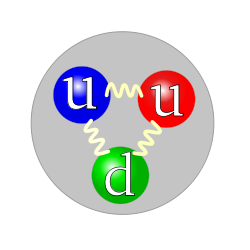
Proton
Did you know...
This wikipedia selection has been chosen by volunteers helping SOS Children from Wikipedia for this Wikipedia Selection for schools. Click here to find out about child sponsorship.
 The quark structure of the proton. |
|
| Composition | 2 up, 1 down |
|---|---|
| Statistics | Fermion |
| Interactions | Gravity, Electromagnetic, Weak, Strong |
| Symbol | p+ |
| Antiparticle | Antiproton |
| Theorized | William Prout (1815) |
| Discovered | Ernest Rutherford (1919) |
| Mass |
1.672 621 71(29) × 10−27 kg 938.272 029(80) MeV/c2 1.007 276 466 88(13) u |
| Electric charge | 1.602 176 53(14) × 10−19 C |
| Spin | ½ |
In physics, the proton (Greek πρώτον / proton = first) is a subatomic particle with an electric charge of one positive fundamental unit (1.602 × 10−19 coulomb), a diameter of about 1.6 to 1.7×10−15 m , and a mass of 938.27231(28) MeV/c2 ( 1.6726 × 10−27 kg), 1.007 276 466 88(13) u or about 1836 times the mass of an electron.
Protons are spin-1/2 fermions and are composed of three quarks, making them baryons. The two up quarks and one down quark of the proton are held together by the strong force, mediated by gluons.
Protons and neutrons are both nucleons, which may be bound by the nuclear force into atomic nuclei. The nucleus of the most common isotope of the hydrogen atom is a single proton (it contains no neutrons). The nuclei of heavy hydrogen ( deuterium and tritium) contain neutrons. All other types atoms are composed of two or more protons and various numbers of neutrons. The number of protons in the nucleus determines the chemical properties of the atom and thus which chemical element is represented; it is the number of both neutrons and protons in a nuclide which determine the particular isotope of an element.
History
Ernest Rutherford is generally credited with the discovery of the proton. In 1918 Rutherford noticed that when alpha particles were shot into nitrogen gas, his scintillation detectors showed the signatures of hydrogen nuclei. Rutherford determined that the only place this hydrogen could have come from was the nitrogen, and therefore nitrogen must contain hydrogen nuclei. He thus suggested that the hydrogen nucleus, which was known to have an atomic number of 1, was an elementary particle.
Prior to Rutherford, Eugene Goldstein had observed canal rays, which were composed of positively charged ions. After the discovery of the electron by J.J. Thomson, Goldstein suggested that since the atom is electrically neutral there must be a positively charged particle in the atom and tried to discover it. He used the "canal rays" observed to be moving against the electron flow in cathode ray tubes. After the electron had been removed from particles inside the cathode ray tube they became positively charged and moved towards the cathode. Most of the charged particles passed through the cathode, it being perforated, and produced a glow on the glass. At this point, Goldstein believed that he had discovered the proton. When he calculated the ratio of charge to mass of this new particle (which in case of the electron was found to be the same for every gas that was used in the cathode ray tube) was found to be different when the gases used were changed. The reason was simple. What Goldstein assumed to be a proton was actually an ion. He gave up his work there, but promised that "he would return." However, he was widely ignored.
Antiproton
The antiparticle of the proton is the antiproton. It was discovered in 1955 by Emilio Segrè and Owen Chamberlain, for which they were awarded the 1959 Nobel Prize in Physics.
CPT-symmetry puts strong constraints on the relative properties of particles and antiparticles and, therefore, is open to stringent tests. For example, the charges of the proton and antiproton must sum to exactly zero. This equality has been tested to one part in 108. The equality of their masses is also tested to better than one part in 108. By holding antiprotons in a Penning trap, the equality of the charge to mass ratio of the proton and the antiproton has been tested to 1 part in 9×1011. The magnetic moment of the antiproton has been measured with error of 8×10−3 nuclear Bohr magnetons, and is found to be equal and opposite to that of the proton.
High-energy physics
Due to their stability and large mass (compared to electrons), protons are well suited to use in particle colliders such as the Large Hadron Collider at CERN and the Tevatron at Fermilab. Protons also make up a large majority of the cosmic rays which impinge on the Earth's atmosphere. Such high-energy proton collisions are more complicated to study than electron collisions, due to the composite nature of the proton. Understanding the details of proton structure requires quantum chromodynamics.
